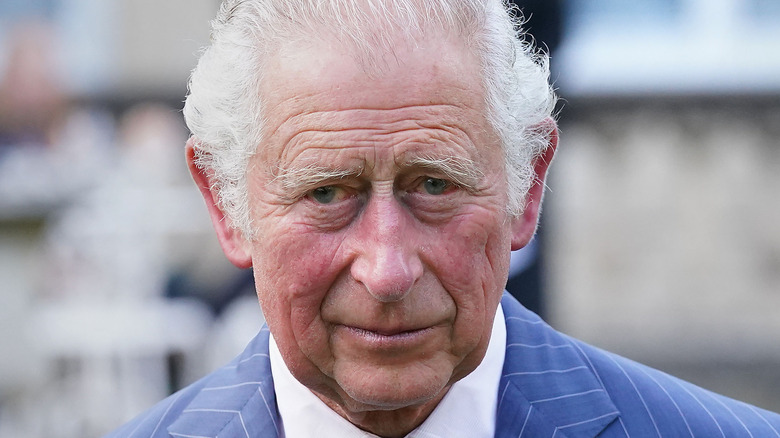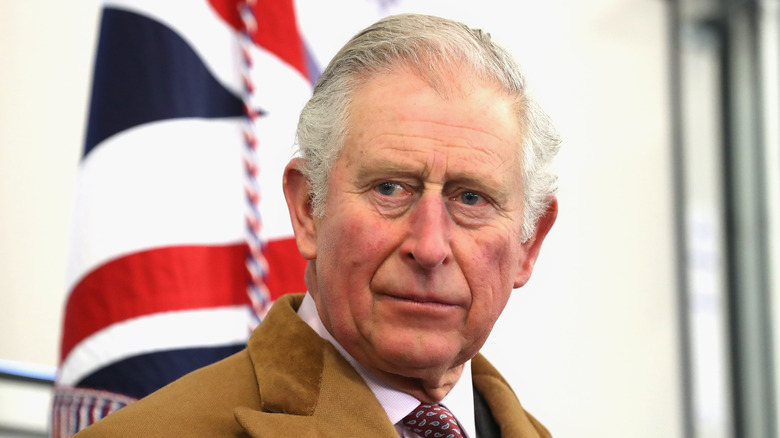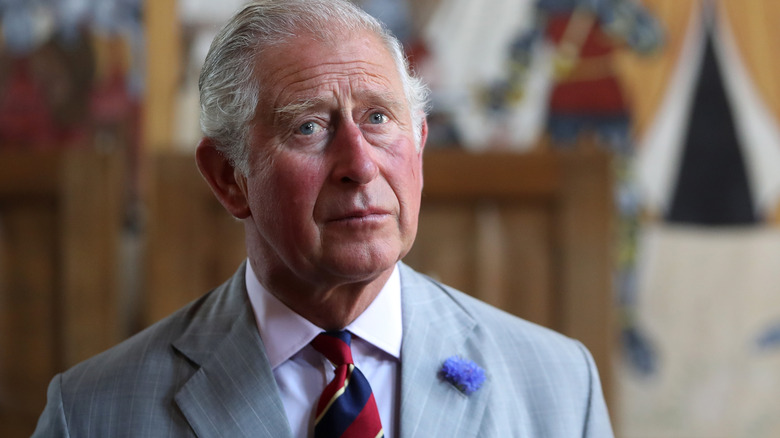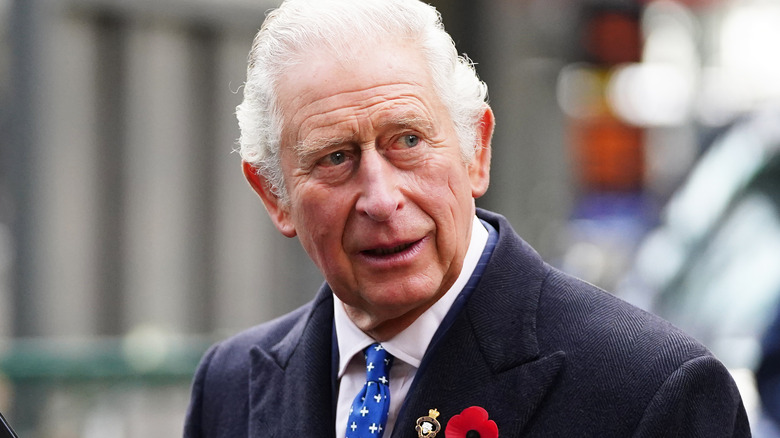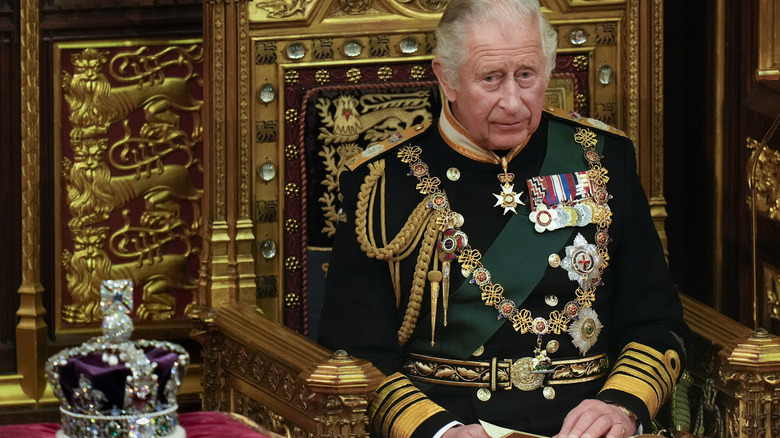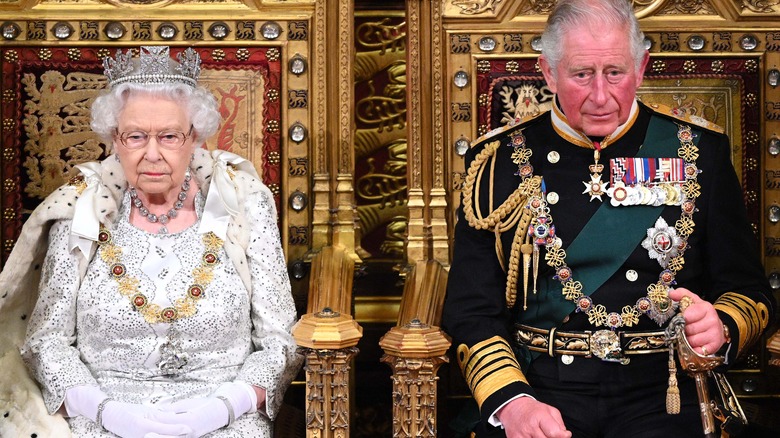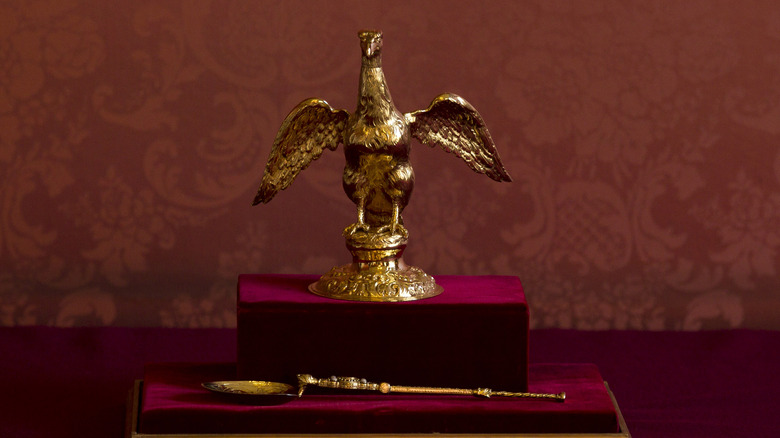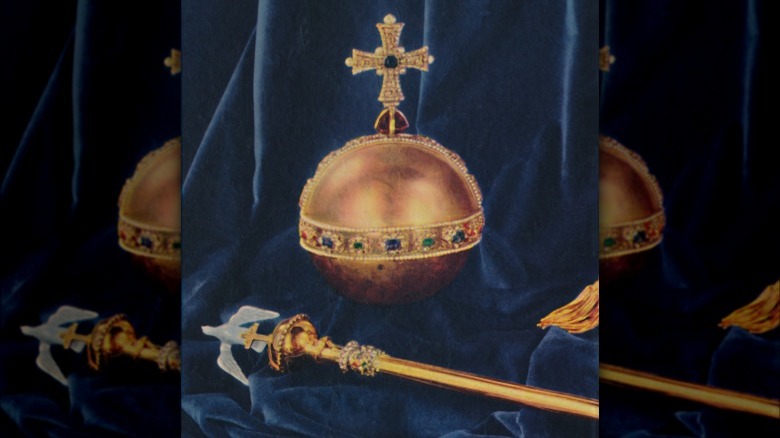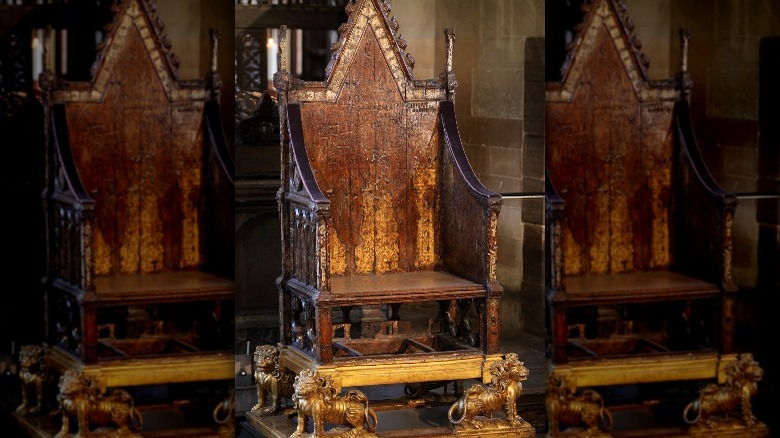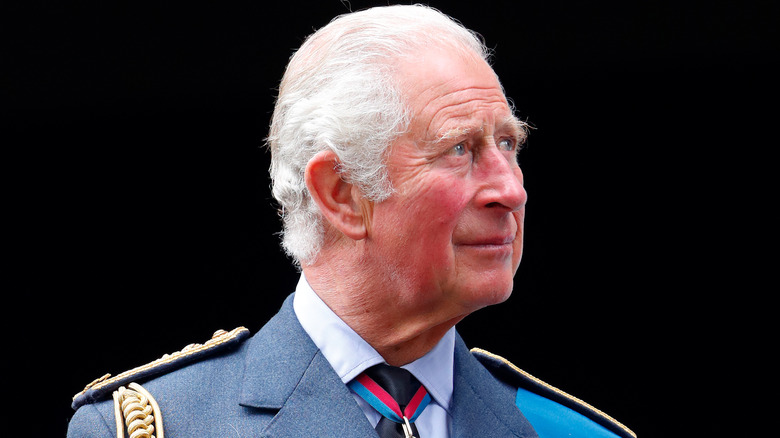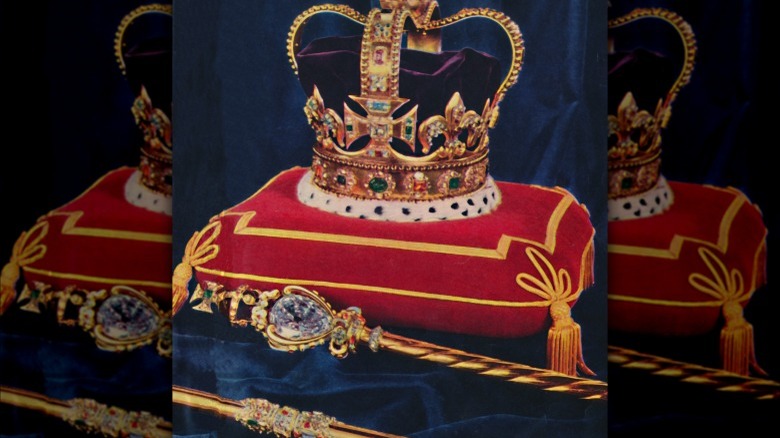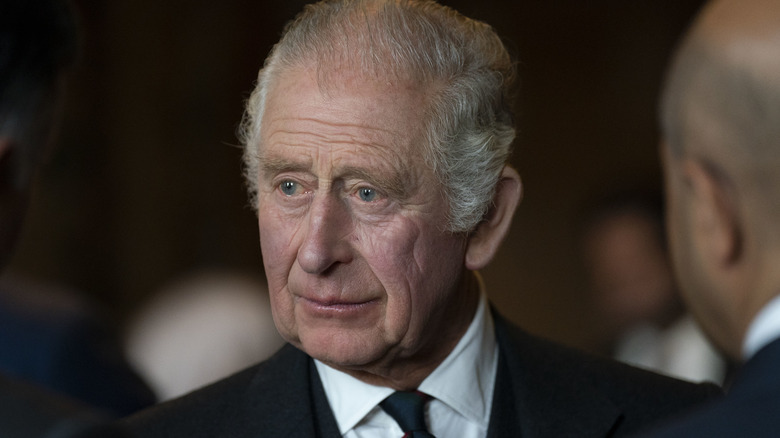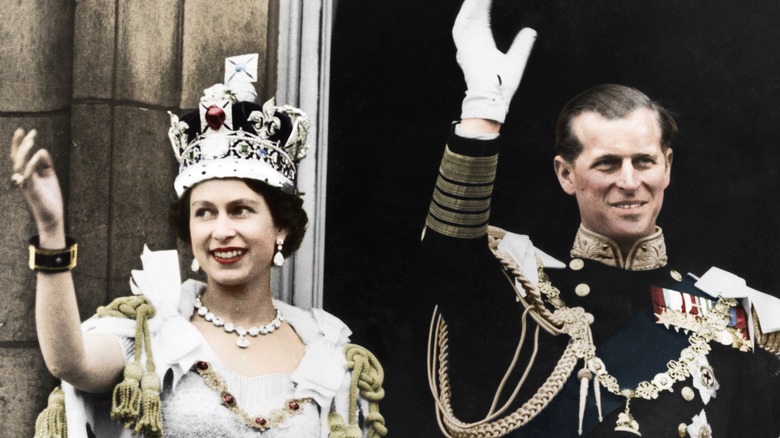Rules King Charles Will Be Forced To Follow At His Coronation
You may think that the king has the final say, but when it comes to royal rules, King Charles III is just the latest monarch in a long line of rulers who all followed the same precedent. Of course, things have changed since the early days of King Edward I, and there's a lot less religious persecution — or beheading. Looking at you, Anne Boleyn. But there are still traditions that are followed. One is the coronation, an incredibly symbolic ceremony that indicates the passing of the crown from one monarch to the next. You might be thinking, "But Charles is already king, what's the point?" That is a great question, and it all has to do with timing.
When Queen Elizabeth II died in September 2022, royal law had it that as soon as she took her last breath, Charles became king. In the immediate aftermath of her death, he traveled the lengths of Great Britain to mourn alongside the members of the public, and of course, officially took over the throne. Given how much planning has to go into the actual coronation ceremony, it's no wonder that it got pushed back. The coronation is scheduled for May 6, 2023 — which just so happens to be Archie Mountbatten-Windsor's birthday — and will be quite the spectacle (even if it's downsized, as Charles has indicated). Here are all the rules he will be forced to follow on the day.
There is one legal rule that King Charles III has to follow on the day
Before we get into it, we should note that there are both laws and rules regarding the coronation — the bulk are rules, or traditions that have been followed for centuries. One in particular, however, is a law, and King Charles III must follow it. Known as the Coronation Oath, the new monarch must swear to rule over the people of Great Britain and the Commonwealth with the phrase, "According to their respective laws and customs." This oath, which Charles must utter, is the only aspect of the coronation that is required by British law. As laid out by Britain's Parliament, this wording allows for any changes made to the governing laws of the United Kingdom and the Commonwealth at large and has evolved since the monarchy took on a ceremonial role.
As part of the oath, Charles will walk down the aisle of Westminster Abbey and make the pledge to serve the citizens of the Commonwealth. A larger aspect of the state event, the oath is just as important as the actual crowning — if not more so — given its legal status. It should be noted that the coronation is, therefore, a state event and is paid for by the British government. In his attempt to modernize the monarchy, Charles has indicated that his coronation will be significantly smaller in scale. Nevertheless, the oath must be carried out accordingly.
The first two processes of the coronation demand these specific garments
When it comes to the coronation, robes and garments worn by the monarch are a big deal. For many, the visual component of the ceremony is the most thrilling, and the two specific garments that King Charles III is required to wear during the first series of processes are quite detailed. As he enters Westminster Abbey, Charles is required to wear something called the Robe of State, or the Parliament Robe. Royal watchers will recognize this as the robe that is worn by the monarch during the opening of Parliament each year. It is a rich crimson velvet and detailed with gold lace, with an ermine lining from Canada.
Next up is the anointing, the process we'll get to in a minute (as it's quite involved). After the anointing, the investiture is next, and this is where all the stops are pulled out. Charles is required to wear a garment called the Colobium Sindonis (more on that later), and over this goes the Supertunica, which is a uniform inspired by the fallen Byzantine Empire. The coat is made of gold silk with large bell sleeves, and is adorned with gold lace and the national symbols of the Commonwealth home nations. The buckle keeping the ensemble together is also detailed with shamrocks, thistles, and roses.
Charles will follow specific rules regarding his dress during the actual anointing
Visually, the anointing part of the coronation is starkly different from the rich velvets and lavish golds that the king will be seen in up until this point. During the anointing, Charles will wear the Colobium Sindonis (which is Latin for "Shroud Tunic") as aforementioned, a sleeveless gown made of plain white linen — no adornments or details will be included.
This is to symbolize the monarch's devotion to God, coming forward with little to no vanity and as much simplicity as one can muster. During this specific part of the coronation, the monarch is anointed with the Coronation Spoon — which is so in-depth that we're dedicating a whole section to that later. This is required to cast away all symbols designating them as the ruler. This includes the Robe of State and the necklace worn in conjunction.
Though her coronation was decades ago in 1953, Queen Elizabeth II's ceremony was unique in that it was televised, allowing the general public to witness an otherwise private ceremony. When she went through the anointing process, she wore a plain white dress with simple pleats and sat stoically as she presented herself. This may seem over the top, but as the British monarch is the head of the Church of England, it makes sense just how involved this process is.
The robes that follow are meant to symbolize the divine aspect of the monarchy
And you thought we were done with robes! After the anointing, King Charles III will wear what's called the Robe Royal, also known as the Imperial Mantle or the Pallium Regale. This is placed on top of the Supertunica and is worn as the investiture takes place as well as for the actual crowning. This robe is incredibly detailed. The garment is "woven in colored threads with a pattern of emblems in a curvilinear pattern of foliage, crowns, fleur-de-lis and eagles with colored roses, thistles, and shamrock woven over, and with gold fringing" (via Royal Collection Trust).
It's all very involved, and though Charles has noted that he wants a scaled-back coronation, these rules regarding robe and dress are pretty much set in stone.
You may be wondering if the king will be wearing the same robes as his mother did, and her father before her, but the king won't have to use secondhand garments. For the bulk of the coronations before him, new robes were made for each monarch except for the Robe Royal and the Supertunica. The former was made for George IV's coronation in 1821, and the latter was made for George V's coronation in 1911. Other than those, Charles will be offered new garments specifically for his coronation, and it's likely that Prince William will be given the same when it's his turn to be crowned.
The anointing has its own set of rules
Now that we've gone over the specific robes that King Charles III will have to wear, we can get into each process. The anointing is one of the most involved aspects of the coronation, and the Act of Consecration is one such part that has to follow a certain set of rules. The 1953 Coronation Committee in charge of Queen Elizabeth II's ceremony deemed that the Act of Consecration — when the Archbishop of Canterbury anoints the new monarch — was so sacred that it had to be conducted out of sight. With this rule in mind, a golden canopy was held over the young queen by four Knights of the Garter in order for this process to be carried out without the craning eyes of others. To say that it was a visual spectacle is an understatement.
During this process — if he follows the rules set forth by his mother — Charles will shed the crimson robe and jewelry and appear in his simple garment of choice (Elizabeth wore a gown, but Charles could opt for something different). Once seated on King Edward's chair, the canopy will once again be held by members of the Knights of the Garter as the archbishop uses the Ampulla — an eagled-shaped golden flask said to be made for King Charles II's coronation in 1661 — to anoint the monarch.
Charles has to be appointed with the use of a special spoon
The coronation day is a big day for spoons, and during the anointing, the coronation spoon must be used to carry out the process. It's so involved and has such a rich history that it truly deserves its own section.
The spoon in question was first recorded in 1349 as part of King Edward's regalia. It's a silver gilt utensil. The bowl of the spoon is engraved with acanthus scrolls and attached to the handle by an intricate carving of a monster's head. The handle is pearl-encrusted and features a second monster's head and a twist. It is just as beautiful as it sounds.
After the spoon remained among the regalia, it was sold in 1649 to a man who worked for King Charles I. He then gifted the spoon to King Charles II for his coronation in 1661, and it has been used in every coronation since. The Ampulla, as aforementioned, is used to pour oil into the spoon, and then the archbishop places the oil on the head, breast, and hands of the monarch. This process dates back to the biblical anointing of Solomon, and is supposed to represent the monarch's connection with religion, divine choice, and spirituality. All in all, it's a great day for spoons.
The investiture has guidelines that Charles will have to follow
As part of the coronation, King Charles III will have to go through the investiture process. This is symbolic of his official crowning and assumption of the throne, but this may lead you to a bit of confusion that we're here to clear up.
Yes, Charles became king by law immediately upon Queen Elizabeth II's death, but given that he still has to take the oath and go through this lengthy process, the symbolic nature of his role as king will be fulfilled. The Royal Household dictates that the coronation marks "the formal investiture of a monarch with regal power." It will also "reflect the monarch's role today and look towards the future, while being rooted in long-standing traditions and pageantry" (per Royal Household).
So, with all that said, we can get to the investiture. This is essentially a fancy word used to describe when the king will be given specific objects designed to represent the monarchy. Wearing the Colobium Sindonis and the Supertunica, Charles will be given the coronation bracelets, also called armills, which are said to symbolize wisdom and sincerity. He will then be given the Imperial Mantle, the royal orb, the coronation ring, and two scepters – the Sovereign's Scepter with Dove and the Sovereign's Scepter with Cross. Visually, the investiture brings onlookers one step closer to seeing the new monarch crowned.
Charles has to sit in King Edward's chair like many sovereigns before him
There's quite a lot of attention paid to the actual throne that monarchs sit in, and as briefly mentioned, King Charles III will have to sit in King Edward's chair during his coronation. This chair is a priceless royal heirloom and is described as one of the most revered pieces of furniture in the world. It has been used during coronations for more than 700 years, if you can believe it, and during the ceremony is placed at the High Altar of Westminster Abbey.
Now, the chair isn't always available for viewing, and if you were to go to Westminster Abbey as a visitor, there's a chance you wouldn't get a glimpse of it. But given its history and specific meaning, it'll most definitely be on full display during Charles' coronation.
The chair was made at the request of King Edward I around 1300, and it's adorned with symbolic imagery of Scotland and England. In fact, the chair was originally made to contain the Stone of Scone. The chair is decorated with bird, animal, and foliage patterns, and later, gilded lions were added to the base in the 16th century. To say that this chair has immense history and meaning is a grave understatement.
Charles won't be allowed to wear the crown right away
But what about the crown? That's the part that we all want to see, right? Well, we hate to break it to you, but it'll be a while into the coronation until you actually see King Charles III with the crown on his head.
Instead, he will wear something called a cap of maintenance – which sounds funny and a bit of an unwelcome substitute — but don't get caught up in the name. This ceremonial cap has just as much symbolism as the other aspects of the coronation and is an important part of regalia related to the British monarchy.
There are all sorts of caps of maintenance for different nobility, according to Hat Guide. In the case of the British monarchy traveling to their coronation, queens have opted for diadems while kings usually wear the cap. Legend has it that caps of maintenance were originally given to Henry VII and Henry VIII by the pope. In fact, these caps were supposedly paraded around London so the public could witness just how impressive their monarch was (per Royal Central). The more you know! So, when it comes to coronation day, Charles will wear a cap of maintenance as he makes his way to Westminster Abbey, following in the footsteps of his grandfather, King George VI.
When crowned, Charles has to remain seated while a prayer is recited
Here's where we get to the good stuff. Of course, we all want to see the moment that the crown is placed on King Charles III's head — no matter what you think of the monarchy, it's a visual spectacle that doesn't happen often. When this happens, the Archbishop of Canterbury will place the crown on Charles' head while he's seated in the Coronation Chair, and he has to stay seated while the archbishop utters a specific prayer, dating all the way back to ancient times.
The prayer, called "Coronet te Deus," will go like this: "God crown you with a crown of glory and righteousness, that having a right faith and manifold fruit of good works, you may obtain the crown of an everlasting kingdom by the gift of him whose kingdom endureth for ever." The guests in attendance will then say, "Amen," because how else are you supposed to end a prayer?
And then, after all that pomp and circumstance, Charles will be seated in the Coronation Chair wearing the big crown and the coronation ring, and holding the scepter, orb, and everything else gifted to him during the investiture (as detailed above). He'll be wearing the robes presented during that specific process. It's all very serious.
Charles might change the rules for this particular aspect of the coronation
We've paid a lot of attention to the anointing process of the coronation, since the 1953 Coronation Committee designated it as such a private process that no one should be allowed to witness it. During the anointing, the Knights of the Garter are supposed to shield the monarch from view with the canopy, the Archbishop of Canterbury does his thing with the spoon, and the choir is supposed to sing "Zadok the Priest" by Handel, which has been sung since King George II's coronation in 1727.
However, King Charles III might chuck a bit of royal tradition to the curb, as it's been reported that a see-through canopy is being made for his coronation.
If he opts for the new canopy, not only will Charles potentially be in public view for the otherwise private aspect of the coronation, but he might even cast aside the tradition of the Knights of the Garter holding the canopy. The Telegraph reports that Charles may instead have students of Christ's Hospital — a boarding school for students from underserved communities — to carry and hold a transparent canopy instead. This could leave the Knights of the Garter out during the ceremony, but this change could be Charles' attempt at being "the people's king."
The king and the royal family will appear on the palace balcony at the end of the ceremony
The last and final rule that King Charles III is required to follow — unless he chooses to ignore yet another storied coronation tradition — is the appearance on the balcony of Buckingham Palace following the crowning. When it was Queen Elizabeth II's turn, she appeared on the palace balcony a total of six times in order to wave at the adoring crowds clamoring for a view of her. It's likely that Charles and Camilla, the queen consort, along with other senior members of the royal family, will follow in this rich tradition.
Of course, some have wondered if the likes of Prince Harry and Meghan Markle — as well as Prince Andrew — will be in attendance and later appear alongside the royal family. Royal correspondent Richard Palmer shared his take on the situation on the Daily Express' Royal Round Up, believing the king will bear no malice to these key family members — to a point.
"My guess is the king will take the moral high ground ... and invite them all to the coronation," Palmer said (via YouTube). He doesn't think, however, that these family members will show up at the balcony. "If I had to guess at this stage ... for how things will work this time around, I don't believe that there will be a place for the Sussexes or the Duke of York on the balcony."
